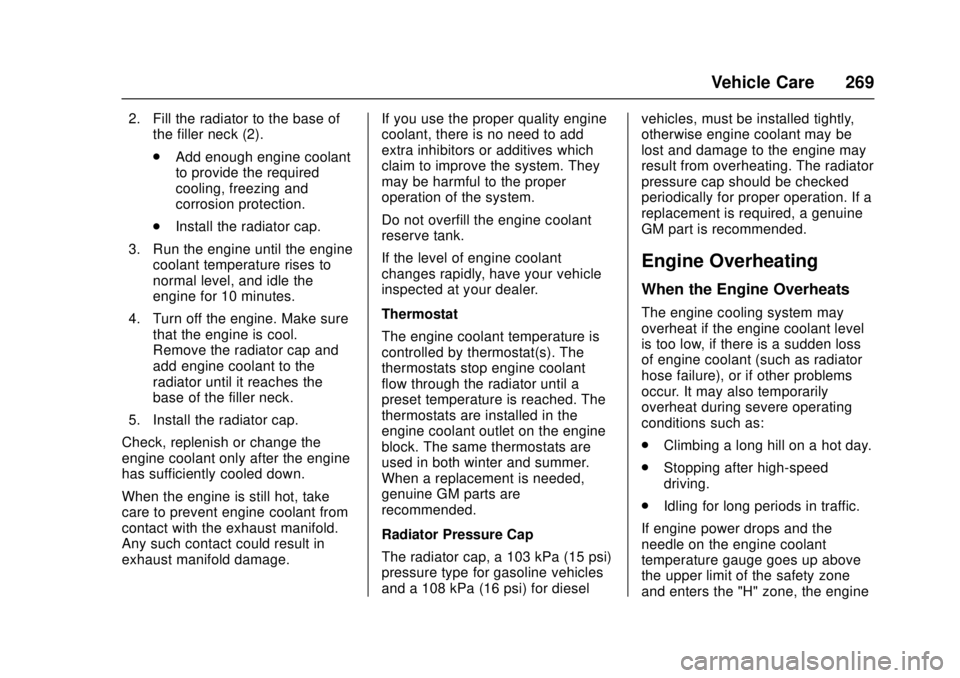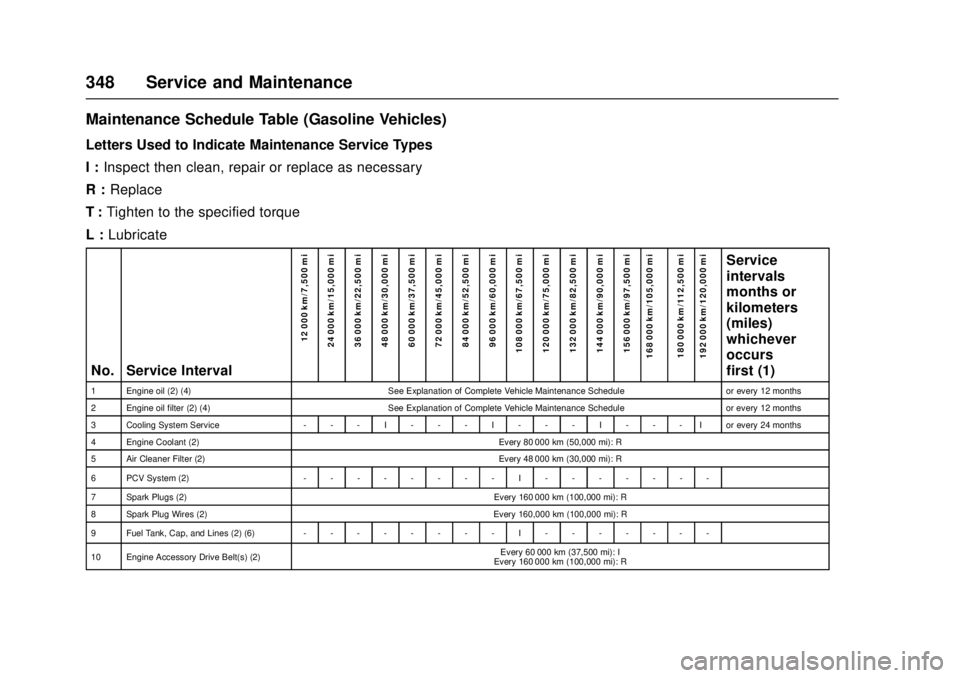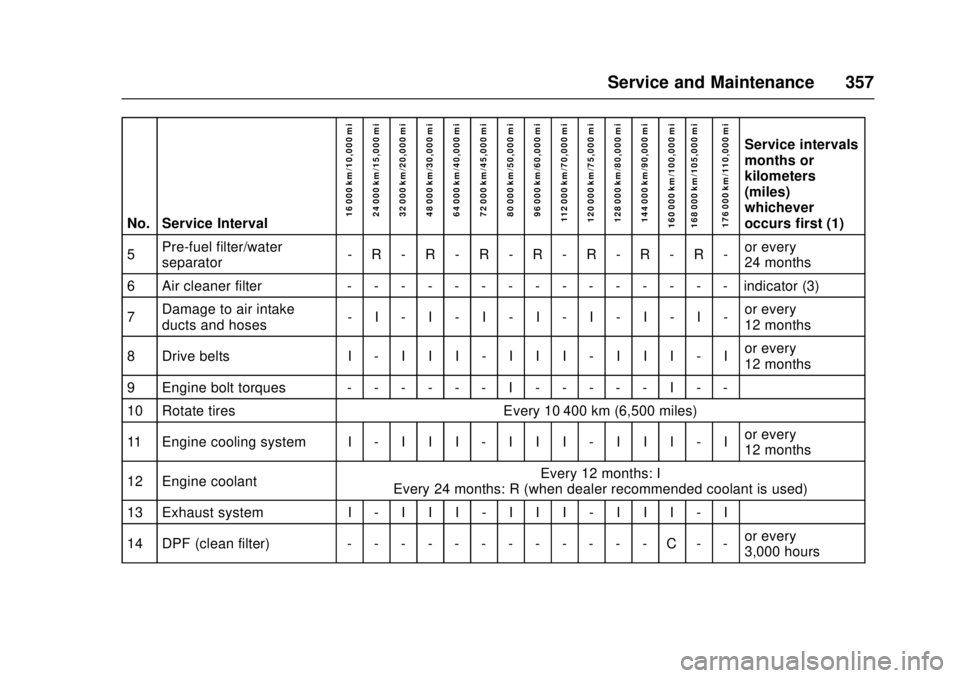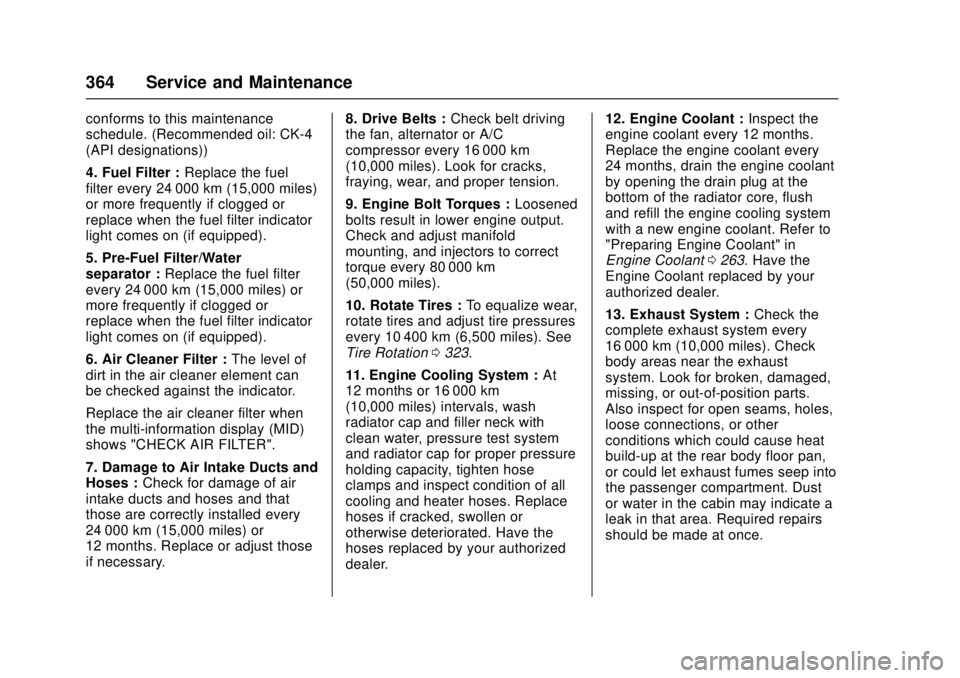engine coolant CHEVROLET LOW CAB FORWARD 2017 Service Manual
[x] Cancel search | Manufacturer: CHEVROLET, Model Year: 2017, Model line: LOW CAB FORWARD, Model: CHEVROLET LOW CAB FORWARD 2017Pages: 414, PDF Size: 7.97 MB
Page 269 of 414

Chevrolet Low Cab Forward Owner Manual (GMNA-Localizing-U.S.-
10716700) - 2017 - crc - 12/6/16
268 Vehicle Care
Crew Cab Model (3.0L Diesel and6.0L Gasoline)Crew Cab Model (5.2L Diesel)
When the engine coolant level in the
engine coolant reserve tank is
below the “MIN”line, open the
reserve tank cap and fill to near the
“MAX” line with engine coolant.
Wash the reserve tank cap and filler
neck with clean water. Tighten the
cap securely after the engine
coolant has been replenished.1. When the engine is cool, remove the radiator cap (1).
.Turn the cap slowly to the
left until it reaches a “stop”.
Do not press down while
turning the cap.
. Wait until any remaining
pressure (indicated by a
hissing sound) is relieved,
then press down on the cap
and continue turning it to
the left.
Page 270 of 414

Chevrolet Low Cab Forward Owner Manual (GMNA-Localizing-U.S.-
10716700) - 2017 - crc - 12/6/16
Vehicle Care 269
2. Fill the radiator to the base ofthe filler neck (2).
.Add enough engine coolant
to provide the required
cooling, freezing and
corrosion protection.
. Install the radiator cap.
3. Run the engine until the engine coolant temperature rises to
normal level, and idle the
engine for 10 minutes.
4. Turn off the engine. Make sure that the engine is cool.
Remove the radiator cap and
add engine coolant to the
radiator until it reaches the
base of the filler neck.
5. Install the radiator cap.
Check, replenish or change the
engine coolant only after the engine
has sufficiently cooled down.
When the engine is still hot, take
care to prevent engine coolant from
contact with the exhaust manifold.
Any such contact could result in
exhaust manifold damage. If you use the proper quality engine
coolant, there is no need to add
extra inhibitors or additives which
claim to improve the system. They
may be harmful to the proper
operation of the system.
Do not overfill the engine coolant
reserve tank.
If the level of engine coolant
changes rapidly, have your vehicle
inspected at your dealer.
Thermostat
The engine coolant temperature is
controlled by thermostat(s). The
thermostats stop engine coolant
flow through the radiator until a
preset temperature is reached. The
thermostats are installed in the
engine coolant outlet on the engine
block. The same thermostats are
used in both winter and summer.
When a replacement is needed,
genuine GM parts are
recommended.
Radiator Pressure Cap
The radiator cap, a 103 kPa (15 psi)
pressure type for gasoline vehicles
and a 108 kPa (16 psi) for dieselvehicles, must be installed tightly,
otherwise engine coolant may be
lost and damage to the engine may
result from overheating. The radiator
pressure cap should be checked
periodically for proper operation. If a
replacement is required, a genuine
GM part is recommended.
Engine Overheating
When the Engine Overheats
The engine cooling system may
overheat if the engine coolant level
is too low, if there is a sudden loss
of engine coolant (such as radiator
hose failure), or if other problems
occur. It may also temporarily
overheat during severe operating
conditions such as:
.
Climbing a long hill on a hot day.
. Stopping after high-speed
driving.
. Idling for long periods in traffic.
If engine power drops and the
needle on the engine coolant
temperature gauge goes up above
the upper limit of the safety zone
and enters the "H" zone, the engine
Page 271 of 414

Chevrolet Low Cab Forward Owner Manual (GMNA-Localizing-U.S.-
10716700) - 2017 - crc - 12/6/16
270 Vehicle Care
is overheating. The engine overheat
warning light will come on and on a
diesel vehicle, the warning buzzer
will sound. Either steam or boiling
engine coolant will squirt out of the
radiator. The diesel vehicle will also
have an“OVER HEAT” message
displayed. Take the following
corrective actions immediately.
{Warning
To help avoid being burned:
Do not tilt the cab or open the
engine access cover if you see or
hear steam or engine coolant
escaping from the engine
compartment. Wait until no steam
or engine coolant can be seen or
heard before tilting the cab or
opening the engine cover.
Do not remove the radiator cap or
engine coolant reserve tank cap if
the engine coolant in the tank is
boiling. Also do not remove the
radiator cap while the engine and
radiator are still hot. Scalding fluid
(Continued)
Warning (Continued)
and steam can be blown out
under pressure if either cap is
taken off too soon.
You and others could be seriously
injured.
If Steam is Coming from the
Engine Compartment
{Warning
If the engine coolant temperature
gauge shows an overheat
condition or you have other
reasons to suspect the engine
may be overheating, continued
operation of the engine (other
than as described here) even for
a short period of time may cause
a fire and the result in personal
injury and severe vehicle
damage. Take immediate action
as outlined.
You and others could be seriously
injured. If you see or hear escaping steam
or have any other reason to suspect
there is a serious overheat
condition, stop and park the vehicle
as soon as it is safe to do so, turn
on the hazard warning flasher and
then turn off the engine immediately
and safely exit the vehicle.
If Steam Is Not Coming from the
Engine Compartment
Page 272 of 414

Chevrolet Low Cab Forward Owner Manual (GMNA-Localizing-U.S.-
10716700) - 2017 - crc - 12/6/16
Vehicle Care 271
For Diesel Vehicle
If the engine coolant temperature
gauge shows an overheat condition,
or you have reason to suspect the
engine may be overheating, take
the following steps: 1. Operate the hazard warning flasher and pull the vehicle
immediately over to a safe
place that does not impede
traffic and park it.
2. For the gasoline engine, if there's no sign of steam,
push the accelerator pedal until
the engine speed is about
twice as fast as normal idle
speed. Bring the engine speed back to normal idle after 2 or
3 minutes. Idle the engine and
wait until the engine coolant
temperature drops to safety
zone. If your air conditioner is
on, turn it off. And turn on the
heater to help the engine
expel heat.
For the diesel engine, idle the
engine and wait until the
engine coolant temperature
drops to safety zone. If your air
conditioner (if equipped) is on,
turn it off. And turn on the
heater to help the engine
expel heat.
3. When the needle of the engine coolant temperature gauge
returns to the middle of the
safety zone, stop the engine.
If the needle of engine coolant
temperature gauge does not
drop inside into the safety
zone, turn the engine off and
have your vehicle serviced at
the nearest dealer.
When the cooling fan for the
radiator is not turning, turn off
the engine immediately.
{Warning
Even when the engine has been
stopped, the engine coolant in the
radiator remains under pressure.
Immediately removing the radiator
cap could cause steam or hot
water to blow out, and you could
be scalded as a result. The
engine coolant in the reserve tank
may also be hot. Immediately
removing the cap could cause hot
water to blow out, and possibly
scald you. Perform inspection,
refilling, and replacement of
coolant only when its temperature
has cooled.
When removing the radiator cap
and reserve tank cap, use a thick
cloth to cover the cap and turn it
little by little.
You and others could be seriously
injured.
Page 273 of 414

Chevrolet Low Cab Forward Owner Manual (GMNA-Localizing-U.S.-
10716700) - 2017 - crc - 12/6/16
272 Vehicle Care
4. If no steam or engine coolantcan be seen or heard from the
engine compartment:
.Tilt the cab or open the
engine access cover.
‐If the engine coolant is
boiling, wait until it stops
before proceeding.
‐ Look at the see-through
reserve tank. The
engine coolant level
should be between the
"MAX" and "MIN" lines
on the reserve tank.
‐ If necessary, pour
engine coolant (See
Engine Coolant 0263
for the proper coolant
and water mixture) into
the reserve tank only,
not directly into the
radiator. Also, do not
check engine coolant
level at the radiator.
. Make sure the fan belts are
not broken, or off the
pulleys, and that the fan
turns when the engine is started. Make sure the fan
blade and pulleys are not
broken.
. Diesel engine only, check
the radiator hoses and
connections, heater hoses
and connections, radiator,
water pump, EGR cooler,
and SCR system and hoses
for leakage.
. Gasoline engine only, if the
engine coolant level in the
reserve tank is low, look for
leaks at the radiator hoses
and connections, heater
hoses and connections,
radiator, and water pump.
If the engine coolant level in
the reserve tank is at the
correct level but there is still
an indication on the
instrument panel of an
overheat condition:
You must let the engine
cool first. You may then add
engine coolant directly to
the radiator. See "Adding
Engine Coolant" under
Engine Coolant 0263. 5. Inspect to see if there is any
dirt, etc. attached to the front
surface of the radiator. Also,
inspect to see if there is
anything blocking the core.
If there is anything attached,
clean and remove it.
6. After the inspection, regardless of the vehicle condition, please
contact the nearest dealer.
Once the engine coolant
temperature gauge no longer
signals an overheat condition, you
can resume driving at a reduced
speed. Return to normal driving
after about 10 minutes if the gauge
pointer does not again show an
overheat condition.
When tap water only has been used
for engine coolant in an emergency,
change the engine coolant as soon
as possible.
Engine damage may be caused if
an overheating engine is suddenly
refilled with water. Instead, refill
slowly.
Page 276 of 414

Chevrolet Low Cab Forward Owner Manual (GMNA-Localizing-U.S.-
10716700) - 2017 - crc - 12/6/16
Vehicle Care 275
Use a high quality premixed solvent
available at most dealers or service
stations.
Avoid hard water when mixing
windshield washer solvents. Hard
water contaminants may plug
orifices in the washer system and
reduce performance.
Do not use radiator antifreeze in the
windshield washer; it could cause
cab paint damage.
In cold weather, warm the
windshield with the defrosters
before using the washer, to help
prevent icing that may block the
driver's vision.Refilling Windshield Washer
Fluid
1. The windshield washer fluidtank (1) is located under the
instrument panel on the
passenger side.
2. Open the cap (2) and fill the tank with windshield washer
fluid.
Upon factory shipment, new
vehicles contain only tap water in
the washer fluid tank. Adjust the
concentration of the fluid to suit your
own usage. Follow the instructions provided with
the windshield washer fluid
regarding the ratio for mixing with
tap water.
Poor quality products, engine
coolant, and soapy water must not
be used. Failure to observe this
precaution can result in nozzle
blockage or damage to painted
surfaces.
The washer should never be used
while the tank is empty. Operating
the washer with the tank empty can
result in motor damage.Brakes
For the most effective braking and
for maximum life from brake system
components, follow these
suggestions:
.
Keep any obstructions from
interfering with brake pedal
travel.
. Keep tires properly inflated.
Improperly inflated tires can
reduce the efficiency of the
brakes.
Page 349 of 414

Chevrolet Low Cab Forward Owner Manual (GMNA-Localizing-U.S.-
10716700) - 2017 - crc - 12/6/16
348 Service and Maintenance
Maintenance Schedule Table (Gasoline Vehicles)
Letters Used to Indicate Maintenance Service Types
I :Inspect then clean, repair or replace as necessary
R : Replace
T : Tighten to the specified torque
L : Lubricate
No. Service Interval
12 000 km/7,500 mi
24 000 km/15,000 mi
36 000 km/22,500 mi
48 000 km/30,000 mi
60 000 km/37,500 mi
72 000 km/45,000 mi
84 000 km/52,500 mi
96 000 km/60,000 mi
108 000 km/67,500 mi
120 000 km/75,000 mi
132 000 km/82,500 mi
144 000 km/90,000 mi
156 000 km/97,500 mi
168 000 km/105,000 mi
180 000 km/112,500 mi
192 000 km/120,000 mi
Service
intervals
months or
kilometers
(miles)
whichever
occurs
first (1)
1 Engine oil (2) (4) See Explanation of Complete Vehicle Maintenance Schedule or every 12 months
2 Engine oil filter (2) (4) See Explanation of Complete Vehicle Maintenance Schedule or every 12 months
3 Cooling System Service - - - I - - - I - - - I - - - I or every 24 months
4 Engine Coolant (2) Every 80 000 km (50,000 mi): R
5 Air Cleaner Filter (2) Every 48 000 km (30,000 mi): R
6 PCV System (2) - - - - - - - - I - - - - - - -
7 Spark Plugs (2) Every 160 000 km (100,000 mi): R
8 Spark Plug Wires (2) Every 160,000 km (100,000 mi): R
9 Fuel Tank, Cap, and Lines (2) (6) - - - - - - - - I - - - - - - -
10 Engine Accessory Drive Belt(s) (2) Every 60 000 km (37,500 mi): I
Every 160 000 km (100,000 mi): R
Page 352 of 414

Chevrolet Low Cab Forward Owner Manual (GMNA-Localizing-U.S.-
10716700) - 2017 - crc - 12/6/16
Service and Maintenance 351
Remarks
(1)In case this column is blank,
follow kilometers (miles).
(2) An Emission Control Service.
(3) Initial check at 1 040 km
(650 miles) is required.
(4) See Severe Driving Condition.
(5) A Noise Emission Control
Service.
(6) The California Air Resources
Board has determined that the
failure to perform this maintenance
item will not nullify the emission
warranty or limit recall liability prior
to the completion of vehicle useful
life. GM, however, urges that all
recommended maintenance
services be performed at the
indicated intervals.
Explanation of Complete
Vehicle Maintenance Schedule
(Gasoline Vehicles)
The following is a brief explanation
of each of the services listed in the
preceding Complete Vehicle
Maintenance Schedule for gasoline
vehicles. 1. ENGINE OIL :
Change at
intervals noted below depending
upon driving conditions.
• NORMAL SERVICE - Change
every 12 000 km (7,500 miles) or
12 months whichever occurs first.
• SEVERE SERVICE- Change every
4 800 km (3,000 miles) or 3 months
if you often drive under one or more
of these conditions (a) driving in
dusty areas, (b) frequent idling or
idling for long periods, (c) driving
6 km (4 miles) or less in freezing
weather, or other short trips in cold
weather, where the engine does not
thoroughly warm up. Change oil and
filter as soon as you can after
driving in a dust storm.
2. OIL FILTER : Change at intervals
noted below depending upon driving
conditions.
• NORMAL SERVICE - Change
every 12 000 km (7,500 miles) or
12 months whichever occurs first.
• SEVERE SERVICE- Change every
4 800 km (3,000 miles) or 3 months
whichever occurs first. 3. COOLING SYSTEM SERVICE :
At 24 months or 48 000 km
(30,000 miles) intervals, wash
radiator cap and filler neck with
clean water, pressure test system
and radiator cap for proper pressure
holding capacity, tighten hose
clamps and inspect condition of all
cooling and heater hoses. Replace
hoses if cracked, swollen or
otherwise deteriorated.
Also each 24 months or 48 000 km
(30,000 miles), clean exterior of
radiator core.
4. ENGINE COOLANT :
Every
80 000 km (50,000 miles), drain the
engine coolant by opening the drain
plug at the bottom of the radiator
core, flush and refill the engine
cooling system with a new 50/50
engine coolant solution.
5. AIR CLEANER FILTER : Change
every 48 000 km (30,000 miles).
6. POSITIVE CRANKCASE
VENTILATION (PCV) SYSTEM :
Check that PCV system works
properly. Replace the valve and any
worn, plugged or collapsed hoses
as necessary.
Page 358 of 414

Chevrolet Low Cab Forward Owner Manual (GMNA-Localizing-U.S.-
10716700) - 2017 - crc - 12/6/16
Service and Maintenance 357
No. Service Interval16 000 km/10,000 mi
24 000 km/15,000 mi
32 000 km/20,000 mi
48 000 km/30,000 mi
64 000 km/40,000 mi
72 000 km/45,000 mi
80 000 km/50,000 mi
96 000 km/60,000 mi
112 000 km/70,000 mi
120 000 km/75,000 mi
128 000 km/80,000 mi
144 000 km/90,000 mi
160 000 km/100,000 mi
168 000 km/105,000 mi
176 000 km/110,000 mi
Service intervals
months or
kilometers
(miles)
whichever
occurs first (1)
5 Pre-fuel filter/water
separator
- R - R - R - R - R - R - R - or every
24 months
6 Air cleaner filter - - - - - - - - - - - - - - - indicator (3)
7 Damage to air intake
ducts and hoses - I - I - I - I - I - I - I - or every
12 months
8 Drive belts I - I I I - I I I - I I I - I or every
12 months
9 Engine bolt torques - - - - - - I - - - - - I - -
10 Rotate tires Every 10 400 km (6,500 miles)
11 Engine cooling system I - I I I - I I I - I I I - I or every
12 months
12 Engine coolant Every 12 months: I
Every 24 months: R (when dealer recommended coolant is used)
13 Exhaust system I - I I I - I I I - I I I - I
14 DPF (clean filter) - - - - - - - - - - - - C - - or every
3,000 hours
Page 365 of 414

Chevrolet Low Cab Forward Owner Manual (GMNA-Localizing-U.S.-
10716700) - 2017 - crc - 12/6/16
364 Service and Maintenance
conforms to this maintenance
schedule. (Recommended oil: CK-4
(API designations))
4. Fuel Filter :Replace the fuel
filter every 24 000 km (15,000 miles)
or more frequently if clogged or
replace when the fuel filter indicator
light comes on (if equipped).
5. Pre-Fuel Filter/Water
separator : Replace the fuel filter
every 24 000 km (15,000 miles) or
more frequently if clogged or
replace when the fuel filter indicator
light comes on (if equipped).
6. Air Cleaner Filter : The level of
dirt in the air cleaner element can
be checked against the indicator.
Replace the air cleaner filter when
the multi-information display (MID)
shows "CHECK AIR FILTER".
7. Damage to Air Intake Ducts and
Hoses : Check for damage of air
intake ducts and hoses and that
those are correctly installed every
24 000 km (15,000 miles) or
12 months. Replace or adjust those
if necessary. 8. Drive Belts :
Check belt driving
the fan, alternator or A/C
compressor every 16 000 km
(10,000 miles). Look for cracks,
fraying, wear, and proper tension.
9. Engine Bolt Torques : Loosened
bolts result in lower engine output.
Check and adjust manifold
mounting, and injectors to correct
torque every 80 000 km
(50,000 miles).
10. Rotate Tires : To equalize wear,
rotate tires and adjust tire pressures
every 10 400 km (6,500 miles). See
Tire Rotation 0323.
11. Engine Cooling System : At
12 months or 16 000 km
(10,000 miles) intervals, wash
radiator cap and filler neck with
clean water, pressure test system
and radiator cap for proper pressure
holding capacity, tighten hose
clamps and inspect condition of all
cooling and heater hoses. Replace
hoses if cracked, swollen or
otherwise deteriorated. Have the
hoses replaced by your authorized
dealer. 12. Engine Coolant :
Inspect the
engine coolant every 12 months.
Replace the engine coolant every
24 months, drain the engine coolant
by opening the drain plug at the
bottom of the radiator core, flush
and refill the engine cooling system
with a new engine coolant. Refer to
"Preparing Engine Coolant" in
Engine Coolant 0263. Have the
Engine Coolant replaced by your
authorized dealer.
13. Exhaust System : Check the
complete exhaust system every
16 000 km (10,000 miles). Check
body areas near the exhaust
system. Look for broken, damaged,
missing, or out-of-position parts.
Also inspect for open seams, holes,
loose connections, or other
conditions which could cause heat
build-up at the rear body floor pan,
or could let exhaust fumes seep into
the passenger compartment. Dust
or water in the cabin may indicate a
leak in that area. Required repairs
should be made at once.